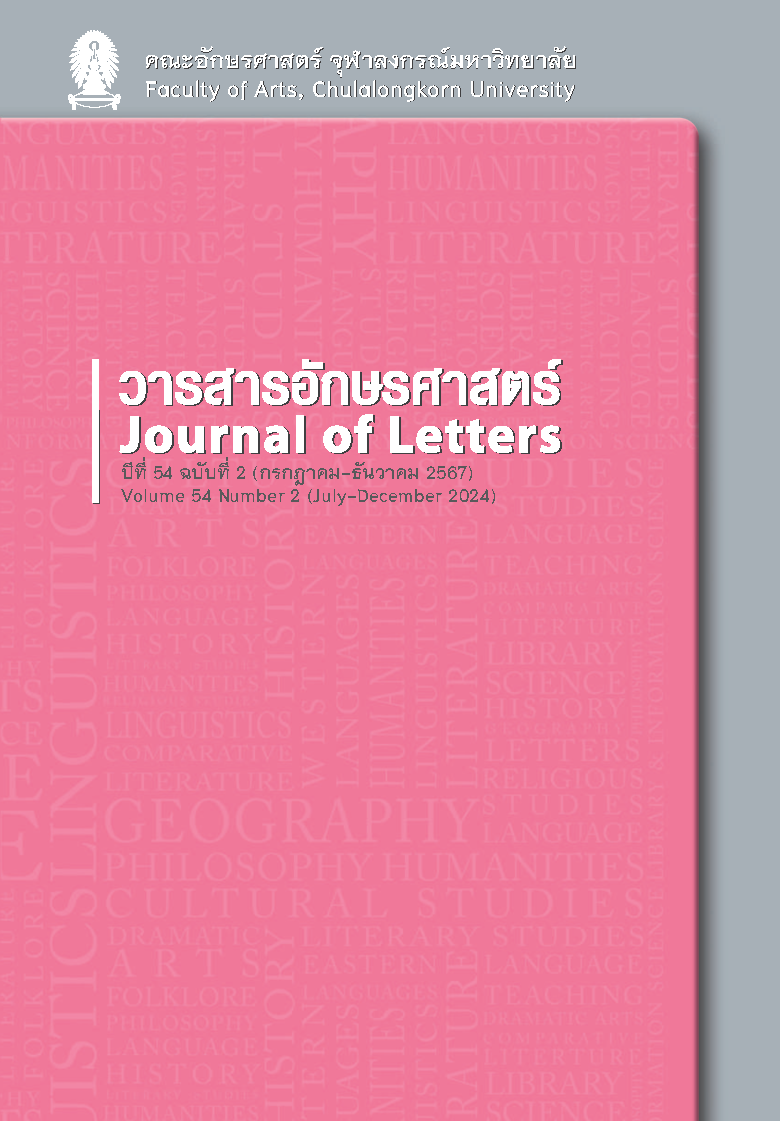Poetic Qualities in Ancient India and Their Legacy in Rabindranath Tagore’s Aesthetic Theory
Keywords:
ancient Indian poets, pratibhā, śakti, Sahṛdaya , Rabindranath TagoreAbstract
Poets in ancient India have been recognized as sages, instructors, and individuals who uplift humanity’s spiritual cultivation through their literary creations, which are enlightening, beautiful, and full of profound philosophical and religious insights. Kāvyaśāstra, which refers to ancient Indian treatises on poetic theories, holds that the qualities of a true poet are creative power (pratibhā) and the skill or talent (śakti) to transform ordinary language into beautiful poetry. However, even though poets are able to create works that are valuable and timeless, judgment of poetic qualities also depends on reader or audience, who must use empathy in order to comprehend the author’s motives (Sahṛdaya). This article points out that from ancient times in India, poets and literary critics have laid the foundations for systematic and complex theories of literary composition and reading. Ideals of poetic qualities and literary creations have existed in Indian literary culture for ages and have been inherited by Rabindranath Tagore’s aesthetic theory. The study found that Tagore’s works, such as “Gītānjalī” and “The Victory,” are examples of literary works that inherit these ideals, like those of ancient Indian poets recognized as having value by the literary world. Tagore’s writings prompt us to ponder the qualities of the poet and the values of poetry that cannot be taken lightly as in today’s rapidly changing society. In contrast, a poet who creates works needs to have necessary qualifications, and the reader who interprets the poet’s intentions needs to have spiritual sensitivity and look deeply into the poetic world in order to understand the essence of the work and experience its vast aesthetic power.
References
ภาษาไทย
Kittipong Boonkerd กิตติพงศ์ บุญเกิด. (2023). Khi Tan Chali khong Raphin Thon Nat Thakun คีตาญชลีของ
รพินทรนาถ ฐากูร [Gītānjalī of Rabindranath Tagore]. Warasan Thai-Pharata วารสารไทย-ภารต [Thai-Bharat Journal], 39(47), 71-79.
Kulanit Kanareugsa กุลนิจ คณะฤกษ์. (2009). Khanop kham praphan lae thatsana rueang khwamkhit sangsan nai wannakhadi Sansakrit : Sueksa priapthiap chak wannakhadi mahakap kap wannakhadi kao ya ขนบคำประพันธ์และทรรศนะเรื่องความคิดสร้างสรรค์ในวรรณคดีสันสกฤต : ศึกษาเปรียบเทียบจากวรรณคดี
มหากาพย์กับวรรณคดีกาวยะ [Poetic convention and the concept of originality in Sanskrit literature :
A comparative study of Epics and Kavyas] [Doctoral dissertation, Silpakorn University]. SURE. https://sure.su.ac.th/xmlui/handle/123456789/10205
Maneepin Phromsutthirak มณีปิ่น พรหมสุทธิรักษ์. (2008). Prawat wannakhadi Sansakrit ประวัติวรรณคดีสันสกฤต [History of Sanskrit literature]. Silpakorn University Press.
Nehru, Jawaharlal เนห์รู, ยวาหระลาล. (2002). Phop thin India พบถิ่นอินเดีย.[The discovery of India]. (Karuna Kusalasai, Trans.; 4th ed.). Sayam.
Saksi Yaemnadda ศักดิ์ศรี แย้มนัดดา. (1974). Saksi wannakam ศักดิ์ศรีวรรณกรรม [A collection of literary writings by Saksi Yaemnadda]. Odeon Store Press.
Sawitree Charoenpong สาวิตรี เจริญพงศ์. (2014). Samphan sayam nai nam pharata : Botbat khong Raphin Thon Nat Thakun Sawami Sattaya Nanthapuri lae Suphat Chanthara Bot nai saisamphan Thai - India สัมพันธ์สยามในนามภารต : บทบาทของรพินทรนาถ ฐากูร สวามีสัตยานันทปุรีและสุภาส จันทร โบส ในสายสัมพันธ์ไทย-อินเดีย [Cultivating friendship in the name of Bharat : The roles of Rabindranath Tagore, Swami Satyananda Puri and Subhas Chandra Bose in Thai-Indian relations]. Indian Studies Center of Chulalongkorn University.
Tagore, Rabindranath ฐากูร, รพินทรนาถ. (2012). Khitanchali คีตาญชลี [Gītānjalī]. (Karuna - Ruangurai Kusalasai, Trans.; 10th ed.). Mae kham phang.
Tassanee Sinsakul ทัศนีย์ สินสกุล. (1991) Thritsadi kawiniphon Sansakrit ทฤษฎีกวีนิพนธ์สันสกฤต [Theory of Sanskrit poetry]. Warasan Aksonsat วารสารอักษรศาสตร์ [Journal of Letters], 23(1), 15-31. https://digital.car.chula.ac.th/jletters/vol23/iss1/2
ภาษาต่างประเทศ
Banerjee, N. (2011). Tagore, Gītānjalī and the Nobel Prize. In U. N. Singh & N. Suri (Eds.), Rabindranath Tagore : A commemorative volume (pp. 32-37). Public Diplomacy Division Ministry of External Affairs.
Belvalkar, S. K. (1924). Kāvyādarśa of Daṇḍin. The Oriental Book-Supplying Agency.
Bhatt, G. H. (1960). The Vālmīki-Rāmāyaṇa. (Vol. 1 The Bālakāṇḍa). The Oriental Institute.
Jha, S. G. (1967). Kāvyaprakāsha of Mammaṭa. Bharatiya Vidya Prakashan.
Kane, P. V. (2002). History of Sanskrit poetics. Motilal Banarsidass Publishers Private Limited.
Kripalani, K. (1980). Rabindranath Tagore : A biography. Visva-Bhatati Calcutta.
Krishanmoorthy, K. (1982). Dhvanyāloka of Ānandavardhana. Motilal Banarsidass.
Macdonell, A. A. (1900). A history of Sanskrit literature. D. Appleton and Company.
Rhys, E. (1915). Rabindranath Tagore : A biographical study. Macmillan and Co., Limited St. Martin’s Street.
Sastri, C. S. R. (1956). Kāvyālaṅkāra of Bhāmaha. The Sri Balamanorama Press.
Sāstrī, T. G. (1909). Trivandrum Sanskrit Series No. IV. Sivalīlārṇava of Nīlakantha Dīkshita. Travancore Government Press.
Sastry, P. V. N. (1991). Kāvyālaṅkāra of Bhāmaha. Motilal Banarsidass.
Schweig, G. M. (2012). A living theology of Krishna Bhakti : Essential teachings of A. C. Bhaktivedanta Swami Prabhupada. Oxford University Press.
Sen, A. (2011). In search of a ‘new’ language for the Bengali theatre. In U. N. Singh, & N. Suri (Eds.), Rabindranath Tagore : A commemorative volume (pp. 202-213). Public Diplomacy Division Ministry of External Affairs.
Singh, U. N. (2010). Tagore in the 21st century. India Perspectives, 24(2), 2-3. https://issuu.com/indiandiplomacy/docs/india_perspective-_special_issue_on_tagore
Śivadatta, P., & Parab, K. P. (1903). The Vāgbhatālaṃkāra of Vāgbhata. Jāvajī Dādājī ‘Nirnaya-sāgar’ Press.
Tagore, R. (1915). Sādhanā: The realisation of life. The Macmillian Company.
Warder, A. K. (1972). Indian Kāvya literature (Vol. 1). Motilal Banarsidass.
Williams, M. M., Sir. (1899). A Sanskrit-English dictionary. Motilal Banarsidass.
Downloads
Published
How to Cite
Issue
Section
License

This work is licensed under a Creative Commons Attribution-NonCommercial-NoDerivatives 4.0 International License.
Copyright and plagiarism
Authors are responsible for obtaining permission to use copyrighted materials from copyright owners. Authors are responsible for observing requisite copyright law when quoting or reproducing copyrighted materials. Quotations and reproductions of content from other published sources must be accompanied by a reference and all sources should be clearly listed in the references section. Quotations and reproductions of content from external sources without due attribution could be considered a severe infringement of academic conduct and may constitute a legal offence under the Copyright Act of B.E. 2537. Any legal ramifications arising from the infringement of copyright regulations would be the sole responsibility of the author(s).



